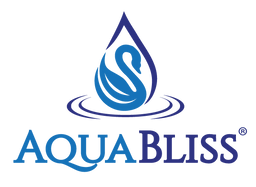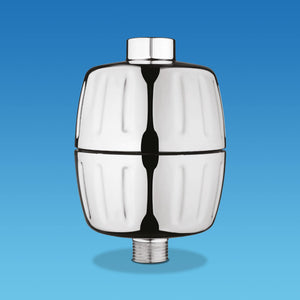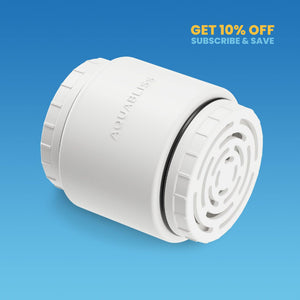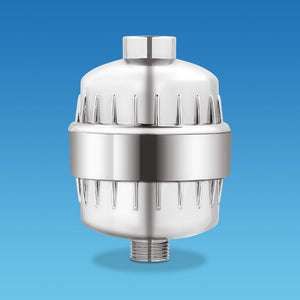Experiencing a weak water stream or slow water flow during the shower? Low water pressure is a common issue for many households. It stems from several sources, including internal plumbing fixtures or even external supply systems.
If you're wondering what causes low water pressure in a shower or what would cause low shower pressure, this guide covers every possibility for you. We're going to explore each and walk through how to fix, test, and prevent low water pressure in your bathrooms.
Plus, we’ll show how using a shower filter, like those from AquaBliss - can help maintain long-term pressure and water quality.
What Is Water Pressure and How Does It Affect Your Shower?
What's the pressure is the force that pushes water through your pipes and out of your shower head. It's measured in PSI, which is pounds per square inch, and it plays a huge role in the quality of your shower experience.
When the pressure is strong and consistent, water flows down in a full and steady stream. You're able to rinse off your shampoo and soap quickly and efficiently, and your shower feels satisfying and effective.
When the water pressure is low, the stream feels weak or lazy. No one wants to stand under a dripping shower, right? Rinsing becomes more difficult, and the experience becomes time-consuming and frustrating.
The ideal residential water pressure typically ranges from 40 to 60 PSI. Anything below 40 is considered low, and pressure below 30 can significantly affect your shower's performance.
What Are the Common Causes of Low Water Pressure in Showers?

If you are asking yourself what can cause low water pressure in a shower, it's essential to consider that there are both internal and external factors. We've put together a list of the most common causes for you below.
1. Faulty pressure regulators.
A pressure regulator or pressure-reducing valve is usually installed where the main water line enters your home. It ensures that the water pressure stays within a safe and usable range.
When this malfunctions, it can cause a sudden drop or inconsistent pressure throughout the house, which you're going to feel when you get under the shower. In the shower, it can lead to a weak stream even when all the other plumbing seems fine.
So your water pressure in your kitchen can be perfect, but your shower pressure can be very low. Regulators can wear out over time or become clogged with debris. If you suspect that your PRV is the culprit, it's best to have a plumber test it or replace it.
2. Faulty mixing valves.
Mixing valves combine hot and cold water before it reaches your showerhead. When these valves clog, corrode, or wear out, they can restrict the flow of water, especially for hot water.
Common signs of a faulty mixing valve include uneven or pulsating water flow, difficulty adjusting the shower temperature, and low pressure only when the hot water is used.
3. A blocked shower head
One of the most overlooked causes of low water pressure in a shower is clogged or dirty shower heads. Even if you're running the right cleansers through your showerhead, mineral deposits from hard water and debris can accumulate in the nozzles.
If you're noticing irregular spray patterns, reduced flow despite normal water pressure elsewhere, and visible scale or residue from the face of the showerhead, you need to give it a good clean.
You can do this with vinegar or replace it with a new shower head entirely, especially one with anti-clogged nozzles. This will solve the issue much faster.
4. Water heater problems.
Low water pressure when using hot water can signal a problem with your water heater, and in this case, you're going to need a plumber for inspection. Common causes of water heater problems include sediment buildup inside the tank that restricts the flow, internal corrosion or leaks, or faulty dip tubes that fail to distribute hot water correctly.
5. Leaking pipes.
Leaks throughout your plumbing system can divert water away from your fixtures, which results in reduced pressure at the showerhead. While there are some leaks that are obvious, such as water stains or pooling, others are hidden within walls or underground.
Low water pressure in just one room or fixture and an unexplained spike in your water bill are top signs of plumbing leaks. A leaky pipe doesn't just lower the pressure either; it will also waste water and increase your utility costs.
6. You're using the wrong showerhead.
Low-flow shower heads are designed to reduce water consumption and are sometimes installed by default in modern homes or rentals. While environmentally friendly, they can sometimes feel too efficient.
If you're asking what would cause low water pressure in your shower, and you're using a low-flow head, the device may be restricting the flow way more than necessary. Upgrading to a modern high-efficiency model designed to maintain good flow will help to solve this problem.
If applicable, you can also remove the flow restrictor disk inside your shower head to increase pressure. Just be aware that this may void water conservation certifications.
7. Water supply issues.
Your local water supplier may also be responsible. During high-demand periods like mornings or summer evenings, pressure from the main supply may drop. Other external issues include municipal pipe repairs, construction work affecting the mains, nearby water main leaks, or restrictions.
Check with your neighbors to see if they're experiencing similar issues. Because if that's the case, the problem is likely at the municipal level.
How to Test Your Shower’s Water Pressure
If you're not sure if your shower pressure is too low or not, here's how you can test it:
- Buy a water pressure gauge, which is available at most hardware stores.
- Choose the right faucet and attach it to an outdoor spigot or laundry tub with a hose connection for accuracy.
- Shut off all of your taps to make sure no other water is being used in the home.
- Turn on the water by opening the valve fully and letting the gauge stabilize.
- Read the PSI. Anything between 40 and 60 is ideal, below 40 is low and below 30 is problematic.
If you want to test your shower specifically, fill a 1-gallon bucket using the shower head and time how long it takes. If it takes more than 24 seconds to fill a gallon, you're getting less than 2.5 GPM, which is a sign of low pressure.
How to Fix a Shower with Low Water Pressure
There are several solutions to fixing a shower with low water pressure, but it all depends on the root cause.
Some of the solutions include:
- Replace your clogged shower heads with newer, cleaner models.
- Soak your shower heads in vinegar overnight to dissolve any mineral deposits.
- Ask a professional to help adjust the PRV or try this one yourself.
- Repair or replace mixing valves that may not be functioning properly.
- Remove sediment buildup by flushing the water heater.
- Repair leaking pipes, especially those hidden in walls or underground.
- Install a booster pump for whole-home low-pressure issues.
- Remove or replace flow restrictors if a low-flow shower head feels inadequate for you.
- Install a high-performance shower filter to reduce mineral deposits that lead to pressure loss.
How to Prevent Low Water Pressure in the Future?
If you're looking to save time, money, and headaches, then preventative care for low water pressure is important in the future. By cleaning your shower heads monthly, you'll prevent mineral buildup from hard water, which can help to keep your low pressure at Bay.
While you're cleaning out your shower heads, flushing your water heater every year can also keep sediment from affecting the water flow. With regular plumbing inspections, you'll be able to check for any small leaks before they become big problems, and you can use water softeners or filters, especially if your area has hard water.
With quality plumbing materials, you can replace galvanized steel pipes with copper or PEX. This can help to stop that buildup. Any unexpected increases in your utility bills every month can signal hidden water leaks, so keep on top of those, too.
How Can a Shower Filter Improve Water Pressure?

Many homeowners don't actually realize that hard water and chlorine can significantly affect not just water quality, but also pressure. The mineral deposits from hard water, such as calcium and magnesium, gradually clog the shower heads and pipes.
Scale buildup reduces the flow through small shower head nozzles, and chlorine and sediments from municipal water supplies can deteriorate seals and valves.
AquaBliss Shower Filters Help Solve These Problems:
With multi-stage filtration that traps sediment, chlorine, heavy metals, and impurities before they reach your skin or your plumbing, you'll be able to speed up your water pressure.
The shower filters can help to reduce buildup, helping to maintain stronger water pressure and the flow of your water. You can also look at protecting sensitive skin. Soft, clean water is often gentler on skin, hair, and scalp.
With no tools needed and quick installation compatible with most shower setups, you'll be able to keep your shower flowing smoothly. Explore the full collection of AquaBliss shower filters here: AquaBliss Shower Filters.
Say Goodbye to Weak Showers
If you've been asking what causes low pressure in the shower, the answer could be anything from simple mineral buildup to large plumbing or municipal issues. Low water pressure is usually caused by faulty regulators, clogged shower heads, and mixing valve issues.
There could even be heater problems or water leaks. Testing your pressure using a gauge can confirm whether intervention is needed, and common fixes often include cleaning the filters, adjusting the regulators, or installing filters and booster systems in the first place.
Preventing future issues through regular maintenance and quality components is important, and installing a high-performance AquaBliss showerhead can help.







